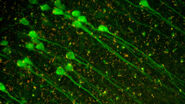Understanding Motor Sequence Generation Across Spatiotemporal Scales
Webinar on-demand

Motor sequences are important elements of everyday behavior, but how they are produced by central neural circuits is poorly understood. The fruit fly exhibits complex behaviors and lends itself to genetic manipulation and imaging techniques that can be used to study neural circuits underlying behavior. We have developed a microscopy-based pipeline to characterize a developmentally critical behavior at the pupal stage of development, called the ecdysis sequence. We study brain-wide neuronal activity with a custom light-sheet microscope, whole-organism behavior at single muscle-fiber resolution and bridge the gap with simultaneous dual-color imaging of muscle activity with sensory neuron or motor neuron activity. These tools allow us to determine the roles of specific populations of neurons in generating motor output.
Key Learnings
- Relevant biological scales for studying motor generation
- Advantages of Drosophila in neurobiology
- Microscopy techniques for multi-scale imaging



